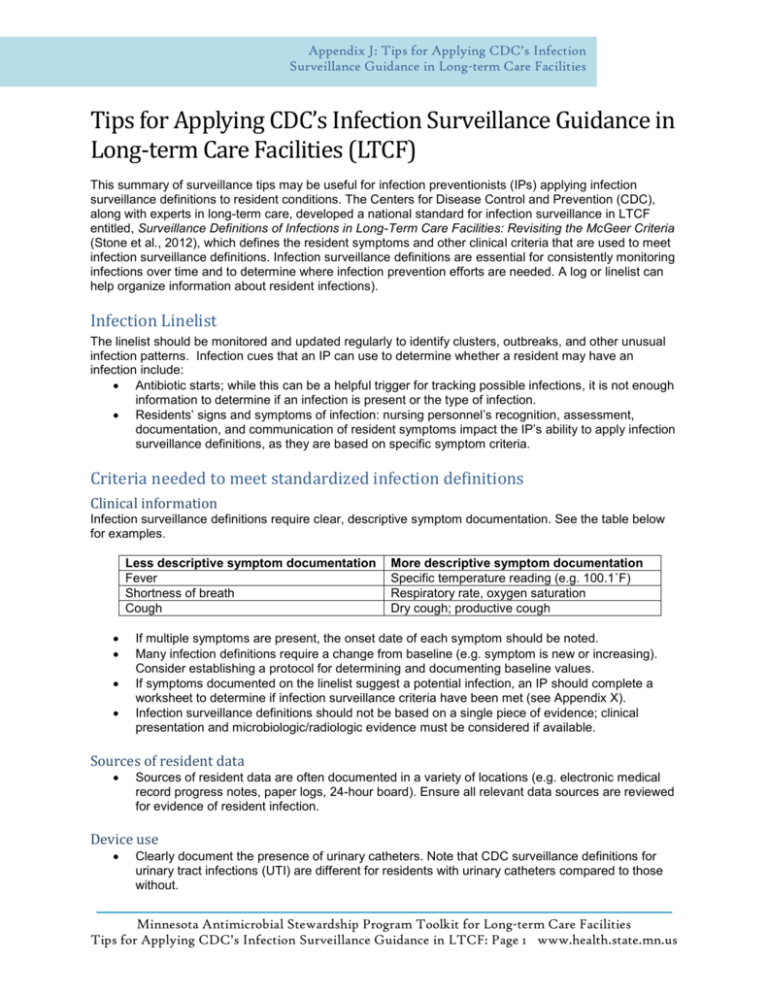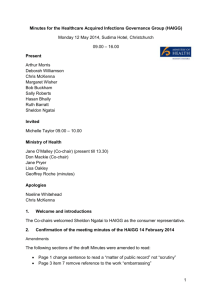Word: 30KB/2 pages
advertisement

Appendix J: Tips for Applying CDC’s Infection Surveillance Guidance in Long-term Care Facilities Tips for Applying CDC’s Infection Surveillance Guidance in Long-term Care Facilities (LTCF) This summary of surveillance tips may be useful for infection preventionists (IPs) applying infection surveillance definitions to resident conditions. The Centers for Disease Control and Prevention (CDC), along with experts in long-term care, developed a national standard for infection surveillance in LTCF entitled, Surveillance Definitions of Infections in Long-Term Care Facilities: Revisiting the McGeer Criteria (Stone et al., 2012), which defines the resident symptoms and other clinical criteria that are used to meet infection surveillance definitions. Infection surveillance definitions are essential for consistently monitoring infections over time and to determine where infection prevention efforts are needed. A log or linelist can help organize information about resident infections). Infection Linelist The linelist should be monitored and updated regularly to identify clusters, outbreaks, and other unusual infection patterns. Infection cues that an IP can use to determine whether a resident may have an infection include: Antibiotic starts; while this can be a helpful trigger for tracking possible infections, it is not enough information to determine if an infection is present or the type of infection. Residents’ signs and symptoms of infection: nursing personnel’s recognition, assessment, documentation, and communication of resident symptoms impact the IP’s ability to apply infection surveillance definitions, as they are based on specific symptom criteria. Criteria needed to meet standardized infection definitions Clinical information Infection surveillance definitions require clear, descriptive symptom documentation. See the table below for examples. Less descriptive symptom documentation Fever Shortness of breath Cough More descriptive symptom documentation Specific temperature reading (e.g. 100.1˚F) Respiratory rate, oxygen saturation Dry cough; productive cough If multiple symptoms are present, the onset date of each symptom should be noted. Many infection definitions require a change from baseline (e.g. symptom is new or increasing). Consider establishing a protocol for determining and documenting baseline values. If symptoms documented on the linelist suggest a potential infection, an IP should complete a worksheet to determine if infection surveillance criteria have been met (see Appendix X). Infection surveillance definitions should not be based on a single piece of evidence; clinical presentation and microbiologic/radiologic evidence must be considered if available. Sources of resident data Sources of resident data are often documented in a variety of locations (e.g. electronic medical record progress notes, paper logs, 24-hour board). Ensure all relevant data sources are reviewed for evidence of resident infection. Device use Clearly document the presence of urinary catheters. Note that CDC surveillance definitions for urinary tract infections (UTI) are different for residents with urinary catheters compared to those without. Minnesota Antimicrobial Stewardship Program Toolkit for Long-term Care Facilities Tips for Applying CDC’s Infection Surveillance Guidance in LTCF: Page 1 www.health.state.mn.us Microbiology cultures The microorganism species and colony counts from urine cultures should be included on a UTI linelist, as CDC UTI definitions use different parameters based on the method of urine specimen collection: o At least 105 colony-forming units (cfu)/mL of no more than 2 species of microorganisms in a voided urine sample o At least 102 cfu/mL of any number of organisms in a urine sample collected by in-and-out catheter o At least 105 cfu/mL of any organism(s) in a urine sample collected by an indwelling urinary catheter Criteria not used to meet standardized infection surveillance definitions Some changes in resident status, including signs and symptoms, have historically been included on infection linelists, because they were thought to be indicative of a potential infection. The updated infection surveillance definitions are largely based on symptoms localizing to a specific body system (e.g. urinary tract, respiratory tract) or site (e.g. ear, skin). The examples below illustrate change in resident status documentation that should not be used to meet infection surveillance definitions. Behavior and mental status changes. While behavior and mental status changes can be important health indicators that require evaluation and follow-up, mental status changes without additional clinical symptoms will not meet infection surveillance definitions. Falls. A resident experiencing falls should be evaluated and interventions to promote safety implemented, but published studies indicate that a resident fall without additional signs or symptoms of infection is not included as a criterion that meets infection surveillance definitions (Stone et al. 2012). Foul-smelling urine. Malodorous urine can be caused by several factors, including dehydration, diet, medication, or the presence of specific bacteria. Foul-smelling urine alone does not indicate the presence of UTI as described in the CDC infection surveillance definition. History of UTI. Knowledge of a resident’s UTI history may be helpful when making care decisions (e.g. teaching regarding perineal hygiene). However, a resident’s current clinical signs and symptoms should be considered when assessing for a UTI. Positive urinalysis (UA) or urine culture (UC). Urine does not typically contain bacteria, yeast, or white blood cells (pus or pyuria) in younger, healthy people. However, bacteria and pus are frequently found in the urine of elderly and debilitated people due to increased age, chronic disease, functional impairment, invasive devices, dehydration, and other risk factors. A positive UA or UC in the absence of other clinical symptoms of UTI does not meet the CDC infection surveillance definitions. Keep in mind that infection surveillance definitions are different than criteria used for clinical decisionmaking. According to CDC, “the criteria that define infections for surveillance purposes were selected to increase the likelihood that the events captured by application of the definitions are true infections. Presentations of infection in older residents of LTCFs may be atypical, so failure to meet surveillance definitions may not fully exclude the presence of infection.” For additional resources for infection surveillance in LTCF, visit the CDC website for long-term care facilities at: http://www.cdc.gov/longtermcare/staff.html Stone ND, Ashraf MS, Calder J, et al. Surveillance Definitions of Infections in Long-Term Care Facilities: Revisiting the McGeer Criteria. Infection Control and Hospital Epidemiology. 2012;33:965-77. Available at: http://www.jstor.org/stable/10.1086/667743 Minnesota Antimicrobial Stewardship Program Toolkit for Long-term Care Facilities Tips for Applying CDC’s Infection Surveillance Guidance in LTCF: Page 2 www.health.state.mn.us





